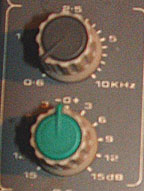Parametric Equalizers
The word parametric means something which has one or more parameters on which the outcome depends. When applied to audio equalization, this means equalization which depends on parameters such as centre frequency, bandwidth and amplitude. The user is able to adjust these parameters to determine exactly how the equalization is applied.
Centre Frequency
 The most important feature of a parametric equaliser is that it allows you to select which frequency to adjust. For example, instead of having a simple mid-range adjustment which boosts or reduces a pre-set range of frequencies, you can specify exactly which mid-range frequency to boost or reduce. This gives you great flexibility and accuracy.
The most important feature of a parametric equaliser is that it allows you to select which frequency to adjust. For example, instead of having a simple mid-range adjustment which boosts or reduces a pre-set range of frequencies, you can specify exactly which mid-range frequency to boost or reduce. This gives you great flexibility and accuracy.
The illustration on the right shows parametric controls for upper-mid-range frequencies. These controls work together — the brown knob determines which frequency is to be adjusted (0.6KHz to 10KHz) and the green knob makes the adjustment (-15dB to +15dB).
Note that although you select a specific frequency, the actual adjustment will apply to frequencies above and below this frequency as well. This is why it is called the centre frequency — it is the frequency at the centre of the adjustment.
Example of use: Let's say you have a feedback problem somewhere in the 5KHz range but you aren't sure of the exact frequency. Turn the green knob right down, then slowly rotate the brown knob through the frequency range. As you do so, you will hear the selected frequencies being reduced. When you reach the frequency which is causing the feedback, the feedback will be reduced.
Bandwidth Control (Q)
As noted above, adjustments are made to a range of frequencies around the centre frequency. The bandwidth control determines how far above and below the centre frequency the adjustment will affect, i.e. the width or spread of frequencies.
A narrow bandwidth adjustment is very specific, useful for accurately removing or accentuating a specific frequency. This would be helpful in the feedback situation described above — once you have identified the offending frequency, reduce the bandwidth so you are adjusting the smallest range possible while still eliminating the feedback.
A broader bandwidth affects more frequencies, useful for adjusting a wider range such as the upper frequencies in a voice. Broader adjustments tend to sound more natural.
Note: Bandwidth controls are not available on all parametric equalizers.
Amplitude
The is the level of adjustment, measured in decibels (dB).